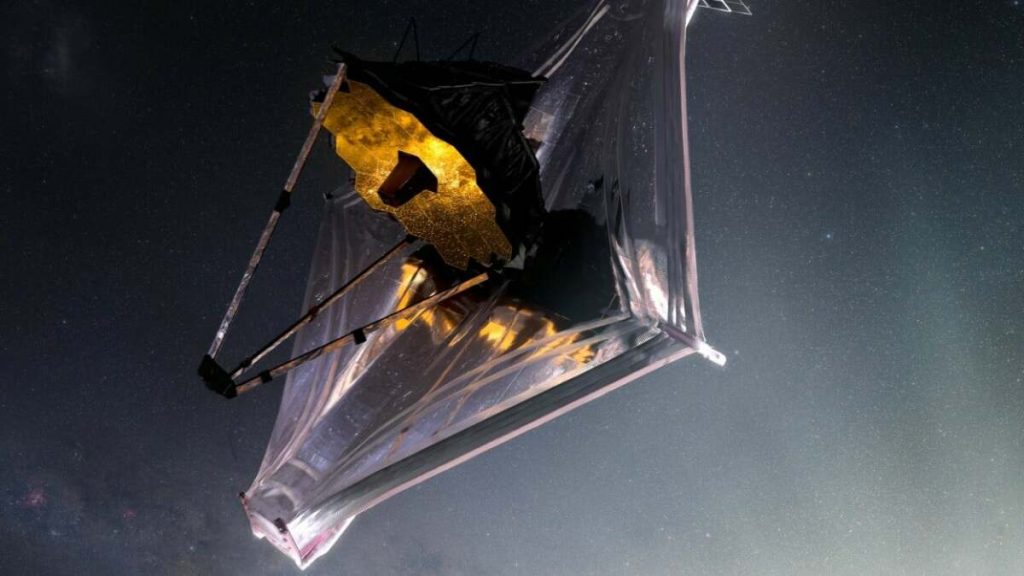
Webb telescope snapped photo of huge world — in a distant solar system (Image Credit: Mashable)
The exoplanet, Epsilon Indi Ab, is located 12 light-years away. That’s trillions of miles, but right next door, cosmically speaking. The world is somewhat like the gas giant Jupiter, but twice as massive. (For reference, “If Earth were the size of a grape, Jupiter would be about as big as a basketball,” NASA notes.)
“This discovery is exciting because the planet is quite similar to Jupiter — it is a little warmer and is more massive, but is more similar to Jupiter than any other planet that has been imaged so far,” Elisabeth Matthews, a scientist at the Max Planck Institute for Astronomy who led the research, said in a statement. The research was published in the science journal Nature.
The Webb telescope, the most powerful space observatory ever built, used a coronagraph to capture the faint light from this far-off planet. A coronagraph blocks light from a specific star while capturing an image. This allows light from the nearby exoplanet to reach Webb.
“Directly detecting planets around other stars is no easy feat,” NASA explains. “Even the nearest stars are still so far away that their planets appear to be separated by a fraction of the width of a human hair held at arm’s length. At these tiny angular scales, the planet’s faint light is lost in the glare of its host star when trying to observe it.”
In the image below, you can see Webb’s coronagraph in action. “A star symbol marks the location of the host star Epsilon Indi A, whose light has been blocked by the coronagraph, resulting in the dark circle marked with a dashed white line,” the space agency said. The orange object is the gas giant Epsilon Indi Ab. Only a “few tens of exoplanets” have been directly imaged before.

Credit: NASA / ESA / CSA / STScI / E. Matthews (Max Planck Institute for Astronomy)
Epsilon Indi Ab, harboring temperatures of some 35 degrees Fahrenheit (2 degrees Celsius), is one of the coldest planets ever directly imaged. As opposed to other gas giants found in the cosmos — which can be thousands of degrees — this world is just some 180 degrees Fahrenheit warmer than our solar system’s gas giants. This allows planetary scientists to research a large, gas exoplanet somewhat like ours. It could be quite cloudy, and it may contain familiar gases like methane, carbon monoxide, and carbon dioxide.
“It’s exciting to actually see a planet there ourselves, and begin to measure its properties.”
“Astronomers have been imagining planets in this system for decades; fictional planets orbiting Epsilon Indi have been the sites of Star Trek episodes, novels, and video games like Halo,” Caroline Morley, an exoplanet researcher at the University of Texas at Austin who worked on the new study, said. “It’s exciting to actually see a planet there ourselves, and begin to measure its properties.”
The Webb telescope’s powerful abilities
The Webb telescope — a scientific collaboration between NASA, the ESA, and the Canadian Space Agency — is designed to peer into the deepest cosmos and reveal new insights about the early universe. But it’s also peering at intriguing planets in our galaxy, along with the planets and moons in our solar system.
Here’s how Webb is achieving unparalleled feats, and likely will for decades to come:
– Giant mirror: Webb’s mirror, which captures light, is over 21 feet across. That’s over two-and-a-half times larger than the Hubble Space Telescope’s mirror. Capturing more light allows Webb to see more distant, ancient objects. As described above, the telescope is peering at stars and galaxies that formed over 13 billion years ago, just a few hundred million years after the Big Bang. “We’re going to see the very first stars and galaxies that ever formed,” Jean Creighton, an astronomer and the director of the Manfred Olson Planetarium at the University of Wisconsin–Milwaukee, told Mashable in 2021.
– Infrared view: Unlike Hubble, which largely views light that’s visible to us, Webb is primarily an infrared telescope, meaning it views light in the infrared spectrum. This allows us to see far more of the universe. Infrared has longer wavelengths than visible light, so the light waves more efficiently slip through cosmic clouds; the light doesn’t as often collide with and get scattered by these densely packed particles. Ultimately, Webb’s infrared eyesight can penetrate places Hubble can’t.
“It lifts the veil,” said Creighton.
– Peering into distant exoplanets: The Webb telescope carries specialized equipment called spectrographs that will revolutionize our understanding of these far-off worlds. The instruments can decipher what molecules (such as water, carbon dioxide, and methane) exist in the atmospheres of distant exoplanets — be they gas giants or smaller rocky worlds. Webb looks at exoplanets in the Milky Way galaxy. Who knows what we’ll find?
“We might learn things we never thought about,” Mercedes López-Morales, an exoplanet researcher and astrophysicist at the Center for Astrophysics-Harvard & Smithsonian, told Mashable in 2021.
Already, astronomers have successfully found intriguing chemical reactions on a planet 700 light-years away, and have started looking at one of the most anticipated places in the cosmos: the rocky, Earth-sized planets of the TRAPPIST solar system.
Topics
NASA





